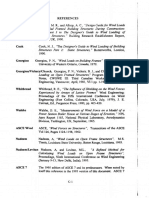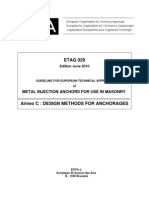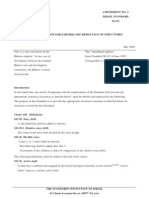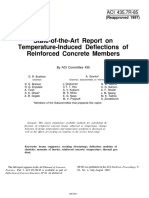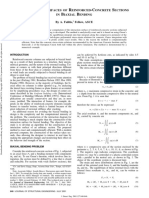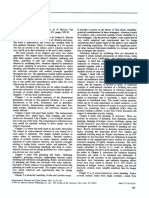0 ratings0% found this document useful (0 votes)
89 viewsVortex-Induced Vibrations of Structures: Svend Ole Hansen
Vortex-Induced Vibrations of Structures: Svend Ole Hansen
Uploaded by
alyaerThe document discusses vortex-induced vibrations that can occur on slender structures from wind. It describes different mathematical models used to predict these vibrations and compares models to results from wind tunnel tests on various cross sections. The comparison of test data to predictions from different models can help identify the most accurate models to guide structural codes.
Copyright:
© All Rights Reserved
Available Formats
Download as PDF, TXT or read online from Scribd
Vortex-Induced Vibrations of Structures: Svend Ole Hansen
Vortex-Induced Vibrations of Structures: Svend Ole Hansen
Uploaded by
alyaer0 ratings0% found this document useful (0 votes)
89 views1 pageThe document discusses vortex-induced vibrations that can occur on slender structures from wind. It describes different mathematical models used to predict these vibrations and compares models to results from wind tunnel tests on various cross sections. The comparison of test data to predictions from different models can help identify the most accurate models to guide structural codes.
Original Title
Hansen_2007 - Copy
Copyright
© © All Rights Reserved
Available Formats
PDF, TXT or read online from Scribd
Share this document
Did you find this document useful?
Is this content inappropriate?
The document discusses vortex-induced vibrations that can occur on slender structures from wind. It describes different mathematical models used to predict these vibrations and compares models to results from wind tunnel tests on various cross sections. The comparison of test data to predictions from different models can help identify the most accurate models to guide structural codes.
Copyright:
© All Rights Reserved
Available Formats
Download as PDF, TXT or read online from Scribd
Download as pdf or txt
0 ratings0% found this document useful (0 votes)
89 views1 pageVortex-Induced Vibrations of Structures: Svend Ole Hansen
Vortex-Induced Vibrations of Structures: Svend Ole Hansen
Uploaded by
alyaerThe document discusses vortex-induced vibrations that can occur on slender structures from wind. It describes different mathematical models used to predict these vibrations and compares models to results from wind tunnel tests on various cross sections. The comparison of test data to predictions from different models can help identify the most accurate models to guide structural codes.
Copyright:
© All Rights Reserved
Available Formats
Download as PDF, TXT or read online from Scribd
Download as pdf or txt
You are on page 1of 1
Structural Engineers World Congress 2007, November 2-7, 2007. Bangalore, India.
Vortex-induced vibrations of structures
Svend Ole Hansen
ABSTRACT
Vortex-induced vibrations may occur on slender structures such as chimneys, towers and
bridge decks. A full analytical description of the phenomenon is still not available, and the
procedures used to predict vortex-induced vibrations of structures are still rather crude.
The different opinions on how to represent the phenomenon mathematically are reflected
in the variety of procedures used in practical designs. For instance, the present Eurocode
on wind actions includes both the spectral model and the vortex-resonance model for
predicting vortex-induced vibrations of structures.
The present paper describes the most important flow and structural characteristics
governing vortex-induced vibrations of structures. The different mathematical approaches
presently used to model the phenomenon are described and their modelings of the different
physical aspects are discussed. The influence of air turbulence and Reynolds number are
some of the physical aspects focused on.
The results obtained in a series of wind tunnel tests recently carried out with different cross
sections, such as circular cylinders, sharp-edged sections, octagons and bridge decks, are
used as a basis for selecting the most accurate mathematical models to predict vortexinduced vibrations of structures. The comparison of the wind tunnel test results with the
predictions obtained from the different mathematical models shows a clear picture of their
accuracy and shortcomings. Thus, the results presented in this paper will be a useful basis
for the future selection of an accurate mathematical model for predicting vortex-induced
vibrations in structural codes.
KEYWORDS
Vortex shedding, vortex-induced vibrations, motion-induced wind loads, turbulence,
spectral model, vortex-resonance model, wind codes.
INTRODUCTION
Although a great deal of effort has been made during recent decades to improve the
analytical models used for predicting vibrations due to vortex shedding, the analytical
models available are still rather crude. The cross-wind forcing mechanisms have proved to
be so complex that there is no general analytical method available to calculate cross-wind
structural response. The main physical parameters involved in the forcing mechanisms
have been clarified, but the basic data used in full-scale predictions have not reached a
general agreement among researchers. Especially, the methods they use to take aeroelastic
effects, i.e. motion-induced wind loads, into account differ considerably.
Two primary design aspects should be focused on in a design procedure:
You might also like
- Robert D. Blevins - Flow-Induced Vibration (2001, Krieger Pub Co) PDFDocument254 pagesRobert D. Blevins - Flow-Induced Vibration (2001, Krieger Pub Co) PDFDang Dinh DongNo ratings yet
- ASIRI Recommandations 2012 TranslatedDocument385 pagesASIRI Recommandations 2012 TranslatedYaseen AlAjmi CompanyNo ratings yet
- Ibc 2003Document10 pagesIbc 2003MIKHA2014No ratings yet
- ASCE 7-22 CH 06 - For PC - SouDocument92 pagesASCE 7-22 CH 06 - For PC - SousharethefilesNo ratings yet
- Base Station Antennas - Reliable Wind Load Calculation: White PaperDocument16 pagesBase Station Antennas - Reliable Wind Load Calculation: White PapersahanNo ratings yet
- Wind Load 102Document1 pageWind Load 102lincah marpaungNo ratings yet
- Effective Lengths of Column and TrussDocument7 pagesEffective Lengths of Column and TrussWilliam CaballeroNo ratings yet
- Experimental Analysis of Flow-Induced Vibration in Lead-Bismuth Cooled Nuclear Fuel AssembliesDocument222 pagesExperimental Analysis of Flow-Induced Vibration in Lead-Bismuth Cooled Nuclear Fuel AssembliesAnonymous zlL9ZGNo ratings yet
- Wind Dynamic AnalysisDocument17 pagesWind Dynamic AnalysisavinashpataskarNo ratings yet
- Some Important Prestressed Silos and Reservoirs in ScandinaviaDocument17 pagesSome Important Prestressed Silos and Reservoirs in ScandinaviaRolando RojasNo ratings yet
- Alan G Davenports Mark On Wind Engineering Isyumov2012Document13 pagesAlan G Davenports Mark On Wind Engineering Isyumov2012Raúl SánchezNo ratings yet
- Applications of Pretensioned Anchor Rods in Industrial FacilitiesDocument10 pagesApplications of Pretensioned Anchor Rods in Industrial FacilitiesAndré Luiz NogueiraNo ratings yet
- Sharma Et Al-2017-Structural Concrete As PublishedDocument9 pagesSharma Et Al-2017-Structural Concrete As PublisheddebiNo ratings yet
- 4 Optimum Prestress of Tanks With Pinned BaseDocument6 pages4 Optimum Prestress of Tanks With Pinned BaseCarlotaGomesNo ratings yet
- Eur 23510 enDocument262 pagesEur 23510 enajra_bgNo ratings yet
- LRFDLTS 1 I3Document16 pagesLRFDLTS 1 I3yvundeNo ratings yet
- Lanjarón Viaduct - Spain: An Innovative Solution With VSL Heavy Lifting For Single Span BridgesDocument2 pagesLanjarón Viaduct - Spain: An Innovative Solution With VSL Heavy Lifting For Single Span BridgesLuis GomezNo ratings yet
- BS 499 European Welding SymbolsDocument5 pagesBS 499 European Welding SymbolsbiancogallazziNo ratings yet
- 1 3 7 Understanding Combinations of Actions 1Document25 pages1 3 7 Understanding Combinations of Actions 1denyfateNo ratings yet
- AASHTO LRFD Guide Seismic 15210 - Rev14 PDFDocument1 pageAASHTO LRFD Guide Seismic 15210 - Rev14 PDFMartaNo ratings yet
- Bridge Deck Analysis Through The Use of Grill Age ModelsDocument8 pagesBridge Deck Analysis Through The Use of Grill Age ModelsOmer Aguilar LunarejoNo ratings yet
- ETA 08-0115 RESTON Spherical and Cylindrical Bearings PDFDocument27 pagesETA 08-0115 RESTON Spherical and Cylindrical Bearings PDFAnonymous apmOvzVzmj100% (1)
- Volume - 4Document85 pagesVolume - 4DEBASIS BARMANNo ratings yet
- Etag 029 Final Edition 2010 06 Annex CDocument11 pagesEtag 029 Final Edition 2010 06 Annex Cninoak1962No ratings yet
- Experience With GalvapulseDocument8 pagesExperience With GalvapulsepatriciacrgNo ratings yet
- Simplified Concrete Modeling: Mat - Concrete - Damage - Rel3Document14 pagesSimplified Concrete Modeling: Mat - Concrete - Damage - Rel3amarNo ratings yet
- NCCI Buckling Lengths of Columns Rigorous ApproachDocument8 pagesNCCI Buckling Lengths of Columns Rigorous ApproachEu SashaNo ratings yet
- İsrail Deprem Yönetmeliği EkiDocument18 pagesİsrail Deprem Yönetmeliği EkiErol Eylemci KaplanNo ratings yet
- Smi Flat SlabDocument6 pagesSmi Flat SlabimadNo ratings yet
- ETA 19 0556 HSL 4 11 2022 Approval Document ASSET DOC 11738371Document59 pagesETA 19 0556 HSL 4 11 2022 Approval Document ASSET DOC 11738371mekrishnababucNo ratings yet
- Problem 1 025Document6 pagesProblem 1 025Oscar SanchezNo ratings yet
- Design of Diagonal Cross Bracings Part 2 Experimental Study PDFDocument5 pagesDesign of Diagonal Cross Bracings Part 2 Experimental Study PDFKhắc ĐăngNo ratings yet
- Report On Code Usage Exercise For DEEPSOIL V2.5 (Installed On An XP Home Edition System)Document12 pagesReport On Code Usage Exercise For DEEPSOIL V2.5 (Installed On An XP Home Edition System)hricha_20No ratings yet
- Asce 7-22 CH 29com - For PCDocument22 pagesAsce 7-22 CH 29com - For PCsharethefilesNo ratings yet
- Effect of Soil On Structural Response To Wind and EarthquakeDocument18 pagesEffect of Soil On Structural Response To Wind and EarthquakeRamesh GantiNo ratings yet
- REDCORTM Weathering Steel HERA GuideDocument32 pagesREDCORTM Weathering Steel HERA Guidejunhe898No ratings yet
- 2013 - Cyclic Failure Analysis of The Beam-To-Column Dowel Connections in Precast Industrial Buildings (Zoubek) PDFDocument13 pages2013 - Cyclic Failure Analysis of The Beam-To-Column Dowel Connections in Precast Industrial Buildings (Zoubek) PDFSebastian BernalNo ratings yet
- Dynamic Soil-Structure Interaction Issues of Offshore Wind Turbines PDFDocument8 pagesDynamic Soil-Structure Interaction Issues of Offshore Wind Turbines PDFAbderraouf KamelNo ratings yet
- 4357r 85 PDFDocument14 pages4357r 85 PDFFred PrzNo ratings yet
- AASHTO Guide Specifications For Strength Design of Truss BridgesDocument13 pagesAASHTO Guide Specifications For Strength Design of Truss BridgesAlberto García MárquezNo ratings yet
- AD346 SecureDocument5 pagesAD346 SecurevongochaiNo ratings yet
- Fib Model Code For Concrete Structures 2010:: Mastering Challenges and Encountering New OnesDocument7 pagesFib Model Code For Concrete Structures 2010:: Mastering Challenges and Encountering New Onesgsmrbharath_91No ratings yet
- Bridge Bearing2Document10 pagesBridge Bearing2sandbad2No ratings yet
- En 1993-1-13 Travi Alveolari AcciaioDocument39 pagesEn 1993-1-13 Travi Alveolari AcciaioAndreaBarberisNo ratings yet
- FHWA-TFHRC Update On Development and DeliveryDocument44 pagesFHWA-TFHRC Update On Development and DeliveryMiguel Angel Contreras OrtizNo ratings yet
- Seismic Design Code of Japan PDFDocument175 pagesSeismic Design Code of Japan PDFtahaelnour0% (1)
- Design and Installation of Concrete Cylinder Piles: Contemporary Issues in Deep FoundationsDocument14 pagesDesign and Installation of Concrete Cylinder Piles: Contemporary Issues in Deep FoundationsHISHAMNo ratings yet
- Verification Manual Russian Code SP 16.13330.2011Document36 pagesVerification Manual Russian Code SP 16.13330.2011adc26100% (1)
- (2005) Flexural Behavior of Confined High-Strength Concrete ColumnsDocument8 pages(2005) Flexural Behavior of Confined High-Strength Concrete ColumnsMohammad AshrafyNo ratings yet
- ETCulvert V2 Brochure Web PDFDocument2 pagesETCulvert V2 Brochure Web PDFjorgesalinasengNo ratings yet
- ACI E702.7-22 Designing Concrete Structures Carbon Fiber-Reinforced Polymer (CFRP) Shear StrengtheningDocument12 pagesACI E702.7-22 Designing Concrete Structures Carbon Fiber-Reinforced Polymer (CFRP) Shear StrengtheningAngus100% (1)
- By Razvi and Saatcioglu (1999) PaperDocument30 pagesBy Razvi and Saatcioglu (1999) Paperkshama hemkarNo ratings yet
- Steel-Concrete Composite Coupling Beams - Behavior and DesignDocument11 pagesSteel-Concrete Composite Coupling Beams - Behavior and DesignFrancisco Javier Torres AlvaradoNo ratings yet
- The Application of Flexural Methods To Torsional Analysis of Thin-Walled Open SectionsDocument10 pagesThe Application of Flexural Methods To Torsional Analysis of Thin-Walled Open SectionsRm1262100% (1)
- 2001 - Interaction Surfaces of Reinforced-Concrete Sections in Biaxial BendingDocument7 pages2001 - Interaction Surfaces of Reinforced-Concrete Sections in Biaxial Bendingryan rakhmatNo ratings yet
- BS en 636 - 2003 PDFDocument15 pagesBS en 636 - 2003 PDFO TottaNo ratings yet
- Bridge Technical Notes Index Oct 2018Document1 pageBridge Technical Notes Index Oct 2018yyanan1118No ratings yet
- 1999-Biaxial Interaction Diagrams For Short RC Columns of Any Cross Section PDFDocument13 pages1999-Biaxial Interaction Diagrams For Short RC Columns of Any Cross Section PDFAlvaro Nicolas Bejarano ParadaNo ratings yet
- Advanced Opensees Algorithms, Volume 1: Probability Analysis Of High Pier Cable-Stayed Bridge Under Multiple-Support Excitations, And LiquefactionFrom EverandAdvanced Opensees Algorithms, Volume 1: Probability Analysis Of High Pier Cable-Stayed Bridge Under Multiple-Support Excitations, And LiquefactionNo ratings yet
- Vortex Induced VibrationsDocument4 pagesVortex Induced VibrationsJohan LorentzonNo ratings yet
- Flow Induced Vibration in Heat ExChangersDocument7 pagesFlow Induced Vibration in Heat ExChangersamrandconanNo ratings yet
- Free Span Analysis PDFDocument57 pagesFree Span Analysis PDFJiggyMHT05 -No ratings yet
- Mechanics of Deepwater Steel Catenary Riser: September 2011Document29 pagesMechanics of Deepwater Steel Catenary Riser: September 2011Ashin VargheseNo ratings yet
- 2018 04 GazzolaDocument182 pages2018 04 GazzolaFederico ZurbriggenNo ratings yet
- Bernard Molin - Offshore Structure Hydrodynamics (Cambridge Ocean Technology Series) - Cambridge University Press (2023)Document444 pagesBernard Molin - Offshore Structure Hydrodynamics (Cambridge Ocean Technology Series) - Cambridge University Press (2023)m,nar100% (3)
- Modeling Steady-State and Transient Forces On A Cylinder: 1.1 Literature SummaryDocument18 pagesModeling Steady-State and Transient Forces On A Cylinder: 1.1 Literature Summarymuhammad sufyanNo ratings yet
- Free Span & FatigueDocument53 pagesFree Span & FatigueaddypurnamaNo ratings yet
- Practical Thermal Design of Shell-and-Tube Heat Exchangers: R. MukherjeeDocument25 pagesPractical Thermal Design of Shell-and-Tube Heat Exchangers: R. Mukherjeesidal babuNo ratings yet
- Design Aids of Offshore Structures Under Special Environmental Loads Including Fire ResistanceDocument344 pagesDesign Aids of Offshore Structures Under Special Environmental Loads Including Fire ResistanceEnriqueNo ratings yet
- InTech-Fluid Structure InteractionDocument23 pagesInTech-Fluid Structure InteractionDeepak MahapatraNo ratings yet
- Effect of Blockage On Vortex Induced VibDocument12 pagesEffect of Blockage On Vortex Induced VibmadhankumargNo ratings yet
- Vortex-Induced Vibration Analysis of The Allegheny Riser Using Shear7Document23 pagesVortex-Induced Vibration Analysis of The Allegheny Riser Using Shear7Annif DaniarNo ratings yet
- Blevins 3Document9 pagesBlevins 3paulomarcalNo ratings yet
- Vortex Induced Vibrations On StructuresDocument9 pagesVortex Induced Vibrations On StructuresJoao SantosNo ratings yet
- DNV RP-F105 (2002) Free Spanning PipelinesDocument39 pagesDNV RP-F105 (2002) Free Spanning PipelinesnimitNo ratings yet
- Simulation of Vortex-Induced Vibrations of A Cylinder Using ANSYS CFXDocument16 pagesSimulation of Vortex-Induced Vibrations of A Cylinder Using ANSYS CFXKalambilYunusNo ratings yet
- Drilling Riser, Wellhead & Conductor Structural Integrity Management in New & Remote Offshore RegionsDocument20 pagesDrilling Riser, Wellhead & Conductor Structural Integrity Management in New & Remote Offshore RegionsImelda PratiwiNo ratings yet
- Aerodynamic Damping of PrismsDocument17 pagesAerodynamic Damping of PrismstrkbrnNo ratings yet
- DNV Os C106Document44 pagesDNV Os C106Wilson Barreta JuniorNo ratings yet
- Design and Development of Vortex Blade Less Wind TurbineDocument3 pagesDesign and Development of Vortex Blade Less Wind TurbineEditor IJTSRD100% (1)
- (PDF) Cross-Flow-Induced-Vibrations in Heat Exchanger Tube Bundles - A ReviewDocument59 pages(PDF) Cross-Flow-Induced-Vibrations in Heat Exchanger Tube Bundles - A ReviewMattNo ratings yet
- Renewable Energy Harvesting by Vortex-Induced Motions: Review and Benchmarking of TechnologiesDocument22 pagesRenewable Energy Harvesting by Vortex-Induced Motions: Review and Benchmarking of Technologiesr_filizadehNo ratings yet
- Flow Induced Vibration 2nd Edition RD Blevins Van Nostrand ReinholdDocument2 pagesFlow Induced Vibration 2nd Edition RD Blevins Van Nostrand ReinholdkhalNo ratings yet
- Design and Fabrication of Energy Harvester Using VIVACE (Vortex Induced Vibrations Aquatic Clean Energy)Document6 pagesDesign and Fabrication of Energy Harvester Using VIVACE (Vortex Induced Vibrations Aquatic Clean Energy)ceceNo ratings yet
- Fluid Motion Energy ConverterDocument16 pagesFluid Motion Energy ConverterAlberto TeodoroNo ratings yet
- Flow-Induced Vibration (FIV) AnalysisDocument3 pagesFlow-Induced Vibration (FIV) Analysischemical todiNo ratings yet
- DNV-Structural Design of TLPS (LRFD Method)Document29 pagesDNV-Structural Design of TLPS (LRFD Method)gelo_17No ratings yet





